ABSTRACT
The aim of this research is to examine the impact of climate change in maize farmers’ livelihood in Zambezi region, Namibia and benefit of adaptation. Trade-off analysis–multidimensional (TOA-MD) model was presented as a method for evaluation with a combination of simulated baseline production and future simulated yield using Decision Support Systems for Agro-technology Transfer (DSSAT) in maize production system, under five different climate scenarios of Global Circulation Models (GCMs). Even though the magnitude and the impact of different GCMs differs, the projections shows to have a negative economic impact with the highest going up to 76% and lowest to be around 46% loss without any adaption strategies in the Zambezi region. Adaptation strategies and some policy options were tested. The analysis suggests that the introduction of an irrigation system may be sufficient to offset the negative effects of climate change. Since various assumptions and uncertainties are associated with using the proposed approach and results should be interpreted with caution. Despite these limitations, the methodology presented in this study shows the potential to yield new insights into the way that realistic adaptation strategies could improve the livelihoods of smallholder farmers. To safeguard the limited productive assets of rural Namibian’s, the study suggested policy aim to target pro-poor disaster management and other adoption mechanism is very important. Apart from protecting productive resources of the rural population, policy should target the diversification of the rural economic environment and strengthen rural-urban linkages.
Key words: Climate change, trade-off analysis–multidimensional (TOA-MD), maize, Namibia, Zambezi.
Although, agriculture sector in Namibia contributes only about 4.1% to the gross domestic product (GDP), however it is regarded as an important part of the economy because it employs 37% of the work force, and sustain 70% of Namibia’s population fully, or to a large extent, depend on agriculture for their livelihoods (CBS, 2012). As a comparison, fishing and fish processing contributed 3.6%, while the mining and quarrying industry still remained the highest contributor at 12.4% in 2010 (CBS, 2012).
Crop farming takes place in communal and commercial areas, with the former highly dependent on the rainfall condition. The combination of long dry spells, floods and the persistence of swarms of red-billed quelea birds during critical stages of crop development led to depressed crop yields. In 2007, the total cultivated area was estimated at around 500000 hectares planted, yet there is a potential to increase the land under cultivation (MWAF, 2009).
Namibia is believed to be known as the most vulnerable countries to climate change in Sub Saharan Africa. As it is characterized by semi-arid to hyper-arid conditions and highly variable rainfall; though small stretches of the country (about 8%) are classified as semi-humid or sub-tropical (MWAF, 2009). Rainfall distribution across the country varies from an average of <25mm per year in some parts of the Namibia Desert to 700mm in some parts of the Caprivi Strip, in the North East. The potential implications of climate change in Namibian small holder agriculture have received more attention in the last decade and several efforts have been made to characterize the impact. However, the methods used to date to assess impacts of climate change on smallholder agriculture are less suited to assess socio-economic impacts. To date, integrated climate change impact assessment that consider climate, biophysical and economic models have not been established for small holder agriculture in Namibia.
Study on impact of climate by Desert Research Foundation of Namibia (DRFN)(2008) indicated detected that trends in rainfall is typically more difficult, especially in highly variable arid climates such as Namibia. Considerable spatial heterogeneity in the trends has been observed, but it appears as if the northern and central regions of Namibia are experiencing a later onset and earlier cessation of rains, resulting in shorter seasons in most vicinities.
Description of the study area
The Zambezi Region, until 2013 known as the Caprivi Region, is one of the 14 regions of Namibia, located in the extreme north-east of the country (Figure 1). It is largely concurrent with the Caprivi Strip and takes its name from the Zambezi River that runs along its border. Katima Mulilo is the capital (17.5000° S, 24.2667° E). The climate of the region is characterized by summer rainfall (October to March), with an average rainfall of about 700 mm per year. In summer, January is the month with the highest average maximum temperature (30°C), and winter in July has the minim lowest average temperature of around 2.5°C.
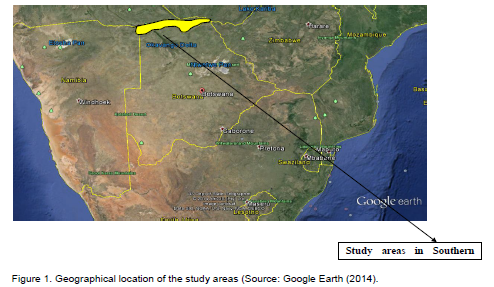
Zambazi region domintley consisting of varying from sand to clay, at one end of the spectrum are heavy soil with high content of clay in areas which are regulary flooded, that is the hydromorphic and organic clay soils. Those areas flooded most frquently hold water for the longest period, and often have a high content of organic materal dervied from decmposed reeds, sedges and other plants that grow in the water. Eastern Zambazi larglery clay-loam and West part of the region more sandy type soil. Genearlly speaking, the region dominated by clay-loam soils (about 35% of the area) and sand (about 50%) (Mandleson, 2011), of all economic activities agricutlure is the most important source of liveslihood the region livelihood depend on farming (both crops and livestock). Large areas have been cleared to plant crops, the continous increasing number of livestock population in the area create heavy grazing on the enviroment.
Due to relatively high rainfall compared to the other regions; as it has been mentioned on the above rainfall, distribution across the country varies from an average of <25 mm per year in parts of the Namibia Desert to 700 mm in some parts of the Zambezi Strip. Secondly, due to existence of
perennial rivers in the region, this provides potential for introduction of small scale irrigation systems in the area.
Overall, the project has three crosscutting themes that emphasise on: uncertainty, aggregation across scales, and representative agricultural pathways (RAPs). The uncertainty explores component of the uncertainty cascade. The aggregation across scales connects local, regional, and global agricultural information (Antle, 2011b). The RAPs processes develop scenarios that connect the representative concentration pathways and the socio-economic pathways (SSPs) that are needed to be included in the model. In this integrated climate change impact assessment research, there are three core questions need to be answered:
1. What is the sensitivity of current agricultural production systems to climate change? Current production system (1980 to 2009 Climate) and future climate current production system (2040 to 2069 Climate), without any adaption and RAPs effect,
2. What is the impact of climate change on future agricultural production systems? (Current production system with future trend on prices and technology on the production system, in addition to considering the effect of RAPs,
3. What are the benefits of climate change adaptations? Future climate production system that includes trend on future climate-adapted production system.
Figure 2 presents the general description of the entire project data processing and methodological framework on the climate assessment: blue colour coded shows the economic component, red for the climate component, green data process for crop modelling and white colour combine both crop and economic modeling. For this report results from the economic modeling only reported indicated blue colour.
Climate data
Due to insufficient data observation from Zambezi region Katima Mulilo station, AgMERRA data were used from Rundu weather around 500 km distance from the study area (climate data was collected by the Namibia weather center). At each location, changes from current climate (1980 to 2010) to near future (2010 to 2040), mid-century (2040 to 2070) and end of century (2070 to 2100) were computed for representative concentration pathways RCP4.5 and RCP8.5. The representative concentration pathways (RCPs) describe the heating effects of atmospheric greenhouse gases (GHGs) at the end of 2100. Twenty global circulation models (GCMs) were used to compute twenty delta changes in monthly temperatures and monthly rainfalls, hence producing 20 possible future weather scenarios per baseline per time period per RCP per station. However, as part of larger fast-track project objective, a first phase presented here consisted in using five of those GCMs only.
Crop data
From different source of literature review and through consultation of agricultural extension officers, the commonly used crop management practices of Zambezi region such as, planting data, soil depth, fertilizer application and harvesting date were used as an input for crop modeling. The physical and chemical properties of the dominant soils information were collected from the data base of Namibia Agricultural research center and some literature review (Mandleson, 2011). In this study, the decision support systems for agro-technology transfer (DSSAT) are used to model the day by day bio-physical growth of maize crops. The model is supported by data base management programs for soil, weather, crop management and experimental. Since the end result of this study was economic analysis, climate and crop results are not reported
Socio-economic data
The data for Zambezi region originate from the project ‘Diversified Agriculture and Livelihood Support Options (DALSO) under the Red Cross initiative collected for which farm survey data were collected in 2012 (Mbai et al., 2013). For this analysis, a selection of 191 farms was extracted from the database for complete data (quantities and prices). For inputs (such as seeds, labor, fertilizer, and manure) assumptions were made for the number of families involved or employed during the season for labor; whereas all farmers used manure as their fertilizer. Livestock income calculated based on the potential hiring of oxen, that is the maximum farmer can hire out would be twenty oxen per season, as plough done in four pair.
Methodology for socio-economic impact
For the analysis of climate change economic impact and adaptation strategies, this study used the Tradeoff Analysis model for Multi-Dimensional Impact Assessment (TOA-MD). This model has been used for the analysis of technology adoption (Antle and Validivia, 2006; Nalukenge et al., 2006; Antle and Stoorvogel, 2006, 2008; Immerzeel et al., 2008; Claessens et al., 2008; Antle, 2011b; Antle and Valdivia, 2011) provides an overview of the methodology, and present a validation of the TOA-MD approach against more complex, spatially-explicit models of semi-subsistence agricultural systems.
In the TOA-MD model, farmers are assumed to be economically rational. This meant that thery make decisions based on maximizing expected value and presented with a simple binary choice: they can continue to operate with production System 1, or they can switch to an alternative System 2 (Antle and Valdivia, 2011). The logic of the analysis is summarized as follows: farmers are initially operating a base technology with a base climate. This combination is defined as System 1. System 2 is defined as the case where farmers continue using the base technology under a perturbed climate. If some farmers are worse off economically under the perturbed climate, they are said to be vulnerable to climate change. Overall vulnerability can be measured by the proportion of farmers made worse off, and can also be defined relative to some threshold, such as the poverty line, in which case it says how many more households are put into poverty by climate change (Antle and Valdivia, 2011).
The simulation model uses data on the spatial variability in economic returns to represent heterogeneity; such as heterogeneity in soils, climate, transportation costs, and the farm household’s characteristics.
It is necessary to distinguish between three factors affecting the expected value of a production system: the production methods used, referred as the technology, and the physical environment in which the system is operating, for example, the climate, and the economic and social environment in which the system is operated. This is the socio-economic setting that we shall refer to as a Representative Agricultural Pathway (RAP) (Antle, 2011b).

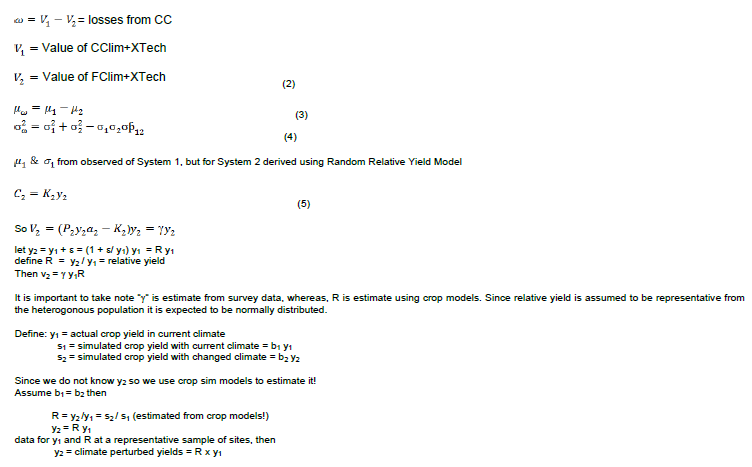
Furthermore, Antle (2011a) show that in an economic adaptation analysis, accurate measurement of the economic, environmental and social impacts of technology adoption must take into account the statistical correlation between factors affecting adoption (For example, economic returns) and the other outcomes of interest. The TOA-MD model is designed to incorporate these correlations into the simulation of impacts on farm income and income-based poverty. In climate change assessment, the TOA-MD model implies that not all farms are affected in the same way – in most cases, some farms lose and some farms gain from climate change. Similarly, some farms may be willing to adopt technologies that facilitate adaptation to climate change, while others will not. The TOA-MD model allows researchers to simulate the impacts of the full range of adoption rates from zero to 100% (Claessens et al., 2008).
Table 1 presents the Namibia case study, the farm systems characterizing for CCSM4 of the Global Circulation Models (GCMs) as an example. On average, those five climate scenarios is predicted to be hotter in the future (+2.0 to +3.5oC), with greater variability in rainfall. Future rainfall/precipitation projections are less consistent, with different climate models revealing different projections in the Southern Africa region.
Question 1: What is the sensitivity of current agricultural production systems to climate change?
The results of the sensitivity of current production systems to future climate change are presented in Table 2. The results show that future climate change is projected to be detrimental to crop production in the Zambezi region (Caprivi) in Namibia. Crop yields are expected to decrease by 11 to 23% due to expected changes in climate 71 to 77% of the farmers in the Zambezi region are expected to lose. Furthermore, Table 3 presents the predication of the model to the farmers’ net welfare. The model predicts the net crop revenue would drop ranges from 38 to 108%, this would yield impacts on mean return would be range from -35 to -60%. Whereas analysis on per capita income (PCI) shows decreases of 38 to 98% due to climate change, while poverty analysis shows that all the farmers below the poverty line would increase ranges from 18 to 46%. The results imply that current crop production systems are sensitive to the effects of climate change.


Question 2: What is the impact of climate change on future agricultural production systems?
Table 4 presents the impact of climate change on future crop production systems in the Zambezi region (Caprivi) region. The results show that about 38 to 65% of the farmers will lose as a result of climate change. Also, future climate change with RAPs and global trend expected to results in decreases in mean yield decrease from -3 to 17%, this would impact net revenues mixed impact for some climate scenarios provided positive and negative net impact. From example, GFDL-west, HadGEM_2ES (west and east), MIROC-5 (East) and MPI-ESM (East) projected to be positive net revenue; whereas, the remaining scenarios would be projected to be negative impact. As indicated in Table 5 with regards to welfare analysis that includes Per Capita Income (PCI) poverty line indicated that climate change will adversely affect livelihoods of Zambezi (Caprivi) substance farmers. For example poverty is expected to reduce marginally in GFDL (west), HadGEM_2ES (west) and MIROC-5 (west) by 1.78, 4.96 and 0.97% respectively. Whereas, for the remaining climate in the model project, there would be adverse effect, especially, GFDL (East) showed hard hit which is estimated to be around 49%; while PCI which is also in the model provided mixed results.
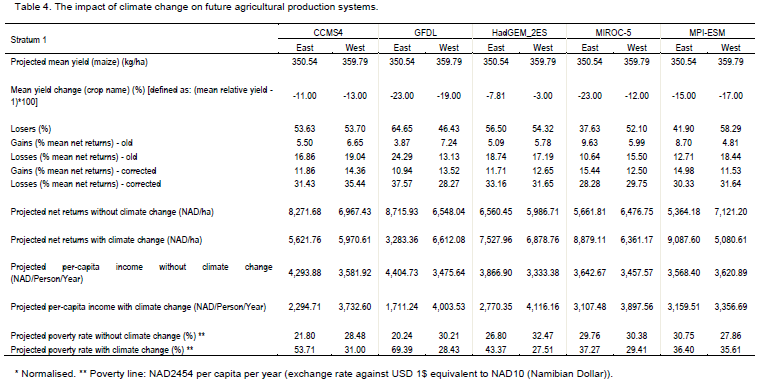

Question 3: What are the benefits of climate change adaptations?
Table 6 shows the benefits of adoption of climate change adaptations on future crop production systems in Namibia (Zambezi region). The adaptation package analysed for this study included the introduction of irrigation as adaptation measures and also RAPs included in the model.
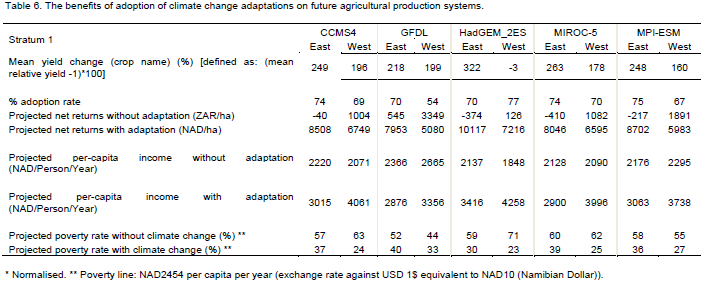
The results show adoption ranging from 54 to 77% of the adapted crop production system under climate change. In addition, the mean yield changes shows an increase ranging from 160 to 322% increase (with exception HadGEM_2ES_West shows 3% reduction). This shows the option of irrigation usage, even over a much smaller land area, would lead maize production to increase at least five-fold while also providing an opportunity for different crop varieties to be grown throughout the year. The overall effect would be to uplift the livelihoods and food security of those living within the study area. From this study, it can be concluded that the introduction of an irrigation system would compensate for the negative effects of climate change. Furthermore, net returns per farm increases by 18 to 29% as a result of adopting the adaptation package.
The results also show that poverty levels decreases by about 12% minimum and 39% maximum when farmers adopt the adaptation package and PCI increases by ranges from 22 to 130%. Generally, the adoption of the adaptation package helps to reduce the negative impacts of climate change of crop production systems in the Zambezi region in Namibia. However, further analysis would be required to test different adaptation packages and RAPS on future crop production system (Table 7).

In summary, Figure 3 presented the impact of climate change on the net impact of farmers return for those three different core questions for WEST Zambezi. As shown in the figure for core question-1 it shows the change in climate for future (but without RAPs and adoption), under this scenario the net impact would be a loss of range from 35 to 46% for the East part of the region under those five different GCMs. For core question-2 that is with changed climate in future, without any adaptation measures, but with some policy change and impact of global market trend. Under this consideration the impact of climate change on the farmers’ net return projected to be a loss of up to 6% on their net return (with only FGDL climate scenario yields 3% gain on the net return). When considering the adaptation for inclusive policy shift which yield a positive and potential offset in the impact of climate change, farmers would gain up 45% of those different climate scenarios.
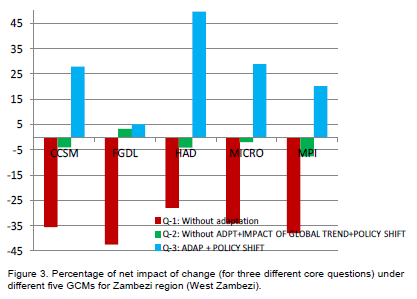
Similar study from IPCC (2014) reported that, there would be an increase in temperatures and changes in precipitation are very likely to reduce cereal crop productivity in Africa (specifically worst in the South-West of Southern Africa). This will have strong adverse effects on food security. New evidence is also emerging that high-value perennial crops could also be adversely affected by temperature rise. Pest, weed and disease pressure on crops and livestock is expected to increase as a result of climate change combined with other factors. Moreover, new challenges to food security are emerging as a result of strong urbanization trends on the continent of Africa and increasingly globalized food chains, which require better understanding of the multi-stressor context of food and livelihood security in both urban and rural contexts in Africa.
Figure 4 presented the impact of climate change on the net impact of farmers return for those three different core questions for EAST Zambezi. As shown in the figure, it is different from the WEST presented earlier.
Vulnerability and adaptation assessments, particularly at the local level, face limited knowledge about exactly what to adapt to Namibia’s natural variability and only exacerbates the shortcomings of global and regional climate models which allow only for broad statements of change. With a view of current technology and future climate change challenges the comprehensive climate assessment was done.
In this study, the TOA-MD model was presented as a method to evaluate the impacts of climate change and the economic viability of adaptation strategies using the kinds of data that are typically available for semi-subsistence systems are important. The method was applied to the maize production systems of the Zambezi region, in Namibia. With a combination of simulated baseline production and future simulated yield using DSSAT in maize production system, under five different climate scenarios to achieve those three core questions of the study. The Economic impacts of climate change to 2050 were analyzed. Even though the magnitude of climate impact differs under different GCMs climate change is projected to have a negative economic impact with the highest going up to 76% and lowest to be around 46% loss without any RAPs and adaption in the Zambezi region. Adaptation strategies were tested for the introduction of irrigation system and by introducing socio- economic scenarios based on Representative Agricultural Pathways.
Highly variable climatic conditions and the risk of extreme events: it is important that policy be developed to safeguard the limited productive assets of rural Namibian’s by means of targeted, pro-poor disaster insurance schemes. Apart from protecting productive resources of the rural population, policy should target at the diversification of the rural economic environment and strengthen rural-urban linkages. These policy directions should receive adequate attention during the formulation of a rural development policy and strategy, which is currently lacking in Namibia’s policy framework. A national debate to clarify the expectations of the agricultural sector to national development, also in lieu of climate change, should be initiated to streamline policies aimed at the sector. Outright conflicting goals prevail which further undermine the potential of this vulnerable sector as well as the sustainable use of the environment.
The authors have not declared any conflict of interests.
This research was sponsored by the USDA and UK-AID, further we would like to acknowledge the coordination and leadership of Agricultural Model Inter-comparison and Improvement project (Agmip) from Colombia University and also the technical support of NASA.
REFERENCES
Antle JM, Valdivia RO (2006). Modelling the supply of ecosystem services from agriculture: a minimum-data approach. Austr. J. Agric. Resour. Econ. 50(2):1–15. Antle JM (2011a). Parsimonious multi-dimensional impact assessment. Am. J. Agric. Econ. 93(5):1292–1311.
Crossref |
|
|
|
Antle JM (2011b). Representative Agricultural Pathways for Model Inter-comparison and Impact Assessment. Available at www.agmip.org/RAPs |
|
|
Antle JM, Stoorvogel JJ (2006). Predicting the supply of ecosystem services from agriculture. Am. J. Agric. Econ. 88(5):1174–1180.
Crossref |
|
|
Antle JM, Stoorvogel JJ (2008). Agricultural carbon sequestration, poverty and sustainability. Environ. Dev. Econ. 13:327–352.
Crossref |
|
|
|
Antle JM, Valdivia R (2011). Methods for Assessing Economic, Environmental and Social Impacts of aquaculture technologies: adoption of integrated agriculture-aquaculture in Malawi. Department of Agricultural and Resource Economics, Oregon State University, Corvallis OR 97331 USA. |
|
|
|
Barnes J, MacGregor J, Alberts M (2012). Expected climate change impacts on land and natural resource use in Namibia: exploring economically efficient responses. Pastoralism: Research, Policy and Practice 2012, 2:22 available: Central Bureau of Statistics (CBS) (2011). Namibian Central Bureau of Statistics (CBS). Available from: http://www.npc.gov.na |
|
|
Claessens L, Stoorvogel JJ, Antle JM (2008). Ex ante assessment of dual-purpose sweet potato in the crop-livestock system of western Kenya: a minimum-data approach. Agric. Syst. 99(1):13–22.
Crossref |
|
|
|
Desert Research Foundation of Namibia (DRFN) (2008). Climate change vulnerability & adaptation assessment Namibia, Windhoek, Namibia. |
|
|
Immerzeel W, Stoorvogel JJ, Antle JM (2008). Can payments for ecosystem services secure the water tower of Tibet? Agric. Syst. 96(3):52–63.
Crossref |
|
|
|
IPCC (2014). Climate Change 2014: Impacts, Adaptation, and Vulnerability. IPCC WGII AR5 Summary for Policymakers. |
|
|
|
Jill EC, Jose C, Zaidi PH, Grudloyma P, Sanchez C, Jose LA, Suriphat T, Makumbi D, Cosmos M, Marianne B, Abebe M, Sarah H, Gary NA (2013). Identification of drought, heat, and combined drought and heat tolerant donors in maize (Zea mays L.). J. Crop Sci. 15(5):22-36. |
|
|
Liao KJ, Tagaris E, Russell AG, Amar P, Manomaiphiboon K, Woo JH (2010). Cost analysis of impacts of climate change on regional air quality. J. Air Waste Manage. Assoc. 60(2):195-203.
Crossref |
|
|
|
Ministry of Agriculture, Water and Forestry (2009). Agricultural Survey. Directorate for Veterinary Services, Windhoek. |
|
|
|
Reid H, Sahlen L, Stage J, MacGregor J (2007). The economic impact of climate change in Namibia: How climate change will affect the contribution of Namibia's natural resources to its economy. Discussion Paper International Institute for Environment and Development (IIED). |